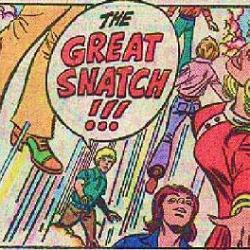So I'm reading a painstakingly thorough work of investigative journalism when suddenly, in Chapter 6, our friend Tim LaHaye makes a surprising and pivotal cameo appearance.
The book I'm reading is Selling Satan: The Evangelical Media and the Mike Warnke Scandal, by Mike Hertenstein and Jon Trott. It expands on the reporting the duo did for Cornerstone magazine in the early 1990s, exposing as a hoax the "Satanism" stories of best-selling Christian-brand author and speaker Warnke, who was swindling millions with his odd combination of "Christian comedy" and grotesque tales of his supposed pre-conversion life as a high priest of Satan.
The authors do a commendably thorough job of debunking and refuting Warnke's claims. Their earnest, devout perspective makes that debunking even more thorough as it requires them to take agonizing pains to avoid bearing false witness or a lack of charity. You'll rarely encounter muckraking conducted with such sorrowful reluctance or such genuine lamentation over every bit of dirty laundry uncovered.
And their case against Warnke is further strengthened, oddly, by the authors' apparent willingness to accept his initial claims as not just possible but plausible. They share the same predisposition that Warnke exploited in his consumer-followers — a religiously based inclination to believe that there really might be an international conspiracy of Satan-worshippers conducting Black Masses and blood rituals while infiltrating the highest levels of government, media and finance. The authors don't start where I might have — by pointing out that no such global satanist conspiracy does or even could exist, but instead they focus primarily on the specific question of whether or not Mike Warnke, as an individual, was really a part of it.
My interest in the Warnke saga is different from Hertenstein and Trott's. They were primarily interested in the question of whether or not Warnke was telling the truth. I'm much more interested in the question of why so many people were so eager and enthusiastic to embrace his lies. As H&T note themselves, those lies were transparent and obvious to anyone who wasn't previously inclined to want to believe them:
Formidable chronological problems exist in [Warnke's alleged memoir] The Satan Seller, totally apart from the historical investigative research which appears in this book. These discrepancies could have been uncovered by anyone else in the past 20 years … with minimal research. But nobody took the time to do the math.
"Formidable chronological problems," in that paragraph, is a euphemism for "clumsy, obvious and flagrant lying." This is what fascinates me. Mike Warnke's success as a lying con artist was not due to his skill as a snakeoil salesman. It was due to his stumbling across an audience desperately eager to spend its money on snakeoil.
Just absorb that for a moment. Warnke was selling a vision of the world that was much, much worse than the reality his audience seemed to be living in. He offered them sordid, Satan-haunted tales of mass torture, rape and human sacrifice routinely occurring in a larger context in which freedom and democracy were merely illusions. And his audience, in turn, ate it up.
Given a choice, they preferred the nightmare. Even though choosing to believe the nightmare required the strain of actively pretending to overlook Warnke's "formidable chronological problems" and demonstrably ridiculous claims.
That astonishes me. I can't quite grasp it. I can understand enduring the strain and the dissonance it requires to pretend to believe a comforting lie, one that offered some illusory solace that might seem worth the price of self-deception. But what on earth motivates millions of people to prefer a horrifying lie that makes the world out to be even worse that it is? Why do millions of people respond to such tales of satanic conspiracies and bloody rituals as though they were reassuring?
Those are the questions that led me to read Selling Satan. And I've got a pile of similar titles on deck — including Warnke's The Satan Seller, Lauren Stratford's Satan's Underground and Jeffrey S. Victor's Satanic Panic: The Creation of a Contemporary Legend.
My fascination with this question is driven, in part, by my attempt to understand the popularity of things like the Tea Party "movement," or the popularity of Glenn Beck and Rush Limbaugh — mendacious peddlers of a politicized version of Warnke's snakeoil.
I had regarded this interest as something wholly separate from my hobby here of dissecting the sublime awfulness of the Left Behind books, but that neat distinction was called into question in Chapter 6 of Selling Satan, as Hertenstein and Trott recount their conversation with none other than Tim LaHaye, who described his encounter with a young Mike Warnke and the way that encounter came to shape and inform the lies Warnke was selling.
During their short stay in San Diego, Mike and [first wife] Sue visited Scott Memorial Baptist Church, pastored by Tim LaHaye, who would later become a well-known evangelical author. Mike Warnke's version of what happened at that meeting was included in The Satan Seller:
I had already told him [LaHaye] I had been to an occult conference. "There were some weird guys that seemed to be the real backers of the whole thing. … I heard the word Illuminati. …"
But Tim LaHaye remembered it differently. "The conversation really wasn't like he put it in his book," said Dr. LaHaye. "I brought up the term Illuminati first. I had been reading a book on the subject called Pawns in the Game, and I tried testing him to see if he really knew anything about it. He didn't seem to have ever heard the word before."
This is delicious. Warnke's shtick up to this point had involved a smallish, parochial version of satanism. His stories up to then had been focused only on the B-movie scenarios of black-robed rituals and bacchanalia in his insular little imaginary "coven." LaHaye's quizzing introduced him to a whole new realm of material with which to embellish his ex-satanist testimony.
After failing the "test" in his conversation with LaHaye, Warnke began reading up on this Illuminati stuff, incorporating the larger mythology into his account. The single "coven" he had described began to be recast as but one branch office of a global satanic conspiracy of puppet-masters secretly running the world.
H&T describe how LaHaye's inadvertent advice is what really enabled Warnke to make the leap from small-time fabulist to mass-market con artist:
In retrospect, if Mike had not added the international conspiracy link to his tale, it might never have left San Bernardino. He would probably never have … become an ex-satanic star. The Illuminati myth was the booster rocket propelling Warnke's story, and it seems only fitting that Warnke's story further popularized the conspiratorial mind-set spreading like an epidemic among evangelicals by the 1980s.
Warnke's new-and-improved, Illuminati-illuminated version of his supposed life as a satanic high priest, H&T write, also led to his presenting his audience with a world in which they could ignore:
… the nature of evil as a banal mystery, profoundly meaningless … Instead it was a grand chess game with Christian and Satanist scooting about the board, a cartoon version of the demonic which left actual evil, a personal as well as corporate matter, virtually untouch
ed.
This image of a cartoony chess ga
me between good and evil will seem familiar to anyone who has read LaHaye's Left Behind series.
But apart from the significance of his influence on Mike Warnke's tapestry of lies, notice what else we learn here about Tim LaHaye. When this young man approached him claiming experience with Satan-worship and the occult, LaHaye's first instinct was to quiz him to see if he was for real. "So you think you know something about Satan-worship, kid? What can you tell me about the Illuminati?"
LaHaye simply assumed, matter-of-factly, that anyone who really worshipped Satan would surely know all about the Illuminati and their secretive cabal running the world from behind the scenes. In LaHaye's mind, this was the truth of the matter. He dismissed the young Warnke as a poser because he didn't seem to know enough about the real satanists and their real international conspiracy of demonic Jewish financiers.
This is what Tim LaHaye believes.
Does this mean that LaHaye is, in fact, stark, raving mad?
It seems hard to see any way not to answer "Yes."
Tim LaHaye clearly believes in things that sane people do not, cannot and will not believe in. Sane people, unlike LaHaye, reject nonsensical theories about the Illuminati because those theories contradict a host of facts they know to be true. For most sane people, casting aside a whole host of truths in exchange for an obvious and ugly lie is not a reasonable choice.
And let's take a moment to reflect on the extreme ugliness of the ugly lie Tim LaHaye has chosen to believe. He cites — as authoritative — the book Pawns in the Game. H&T provide some helpful background on that book and its author (who also wrote, The Devil's Poison: The Truth About the Fluoridation Conspiracy):
William Guy Carr's Pawns in the Game (1958), claimed that all history should be seen through the lens of an Illuminati conspiracy orchestrated by the devil himself through a small band of human agents. …
Carr offered a step-by-step history of the Jewish plotters which was most unflattering. His history explained that Christ was crucified by the Illuminati who used "false priests and elders in their pay" … referring to them as "the Synagogue of Satan." … Carr also suggested that Hitler was an innocent victim of the Illuminati. …
Carr also lent credence to the rabidly anti-Semitic, allegedly Illuminati-authored Protocols of the Learned Elders of Zion: "The document details the plan by which a small group of international financiers have used, and still use, Communism, Zionism and all other agencies they can control … to further their own secret totalitarian ambition."
Crazy, stupid, ugly and racist. And integral to Tim LaHaye's understanding of the world.
This Illuminati insanity isn't some superfluous thread that can be separated from LaHaye's supposedly literal, supposedly biblical prophecy schemes. It's woven throughout his whole vision. Yank out this thread and the whole thing — the End Times Check List, the Antichrist secretary-general, the OWG with its OWC, OWL and OWR — unravels.
LaHaye's premillennial dispensationalism is not, as he claims, based on a literal reading of Daniel and Revelation. It is based, in part, on a literal reading of the Protocols of the Elders of Zion. It is based on lies based on lies based on lies.












